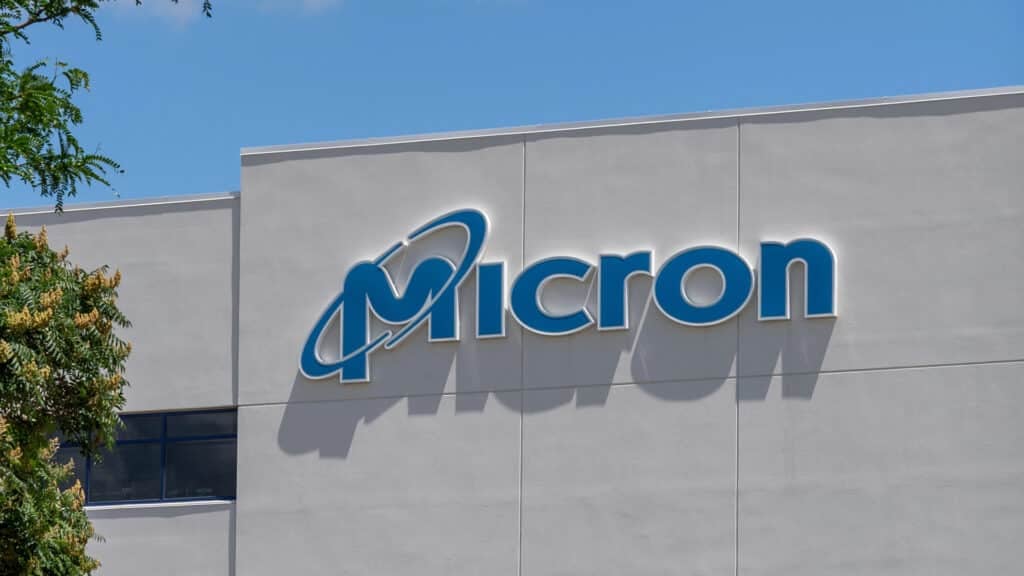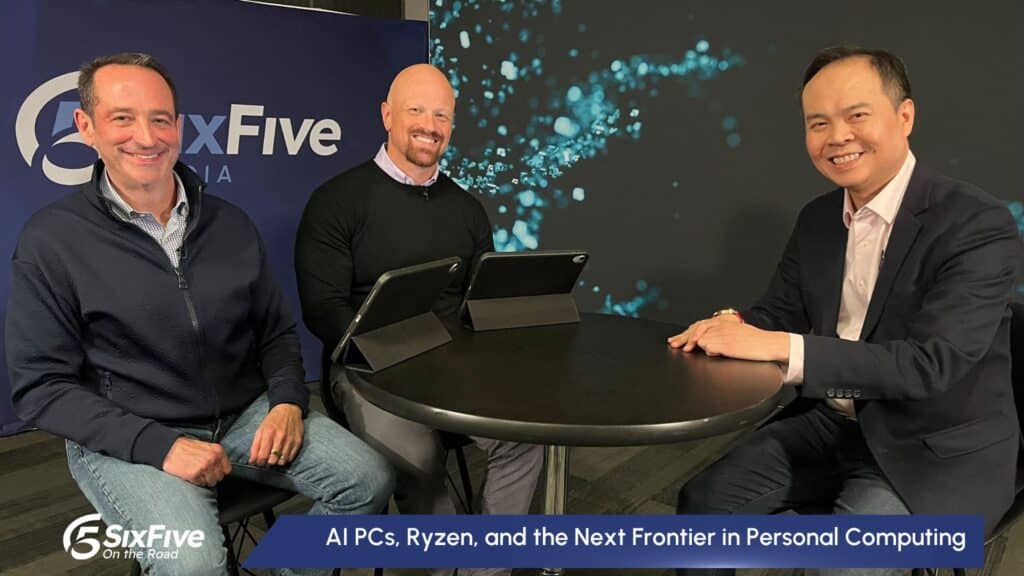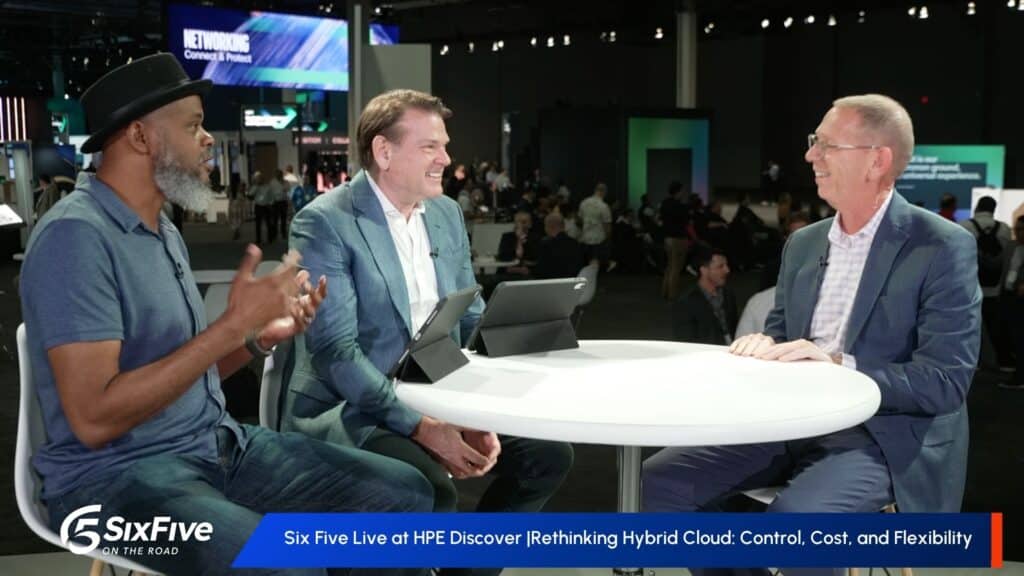How can you future-proof your collocation? Start by combining advanced AI hardware with global data center capabilities. On this episode of Six Five On The Road at SC24, hosts Keith Townsend and David Nicholson are joined by Lenovo’s CMO Flynn Maloy and Digital Realty’s Chief Executive of Alliances – Global Sales, Seamus Matthews for a conversation on how their collaboration addresses the increasing demand for #AIinfrastructure and sustainable data center solutions.
Watch the full video for more on 👇
- The strategic partnership between Lenovo and Digital Realty to bring advanced AI hardware and global data center capabilities to enterprises, optimizing AI deployment sustainability and efficiency
- How Digital Realty’s colocation services and infrastructure solutions support the scalability of global IT operations along with the integration of hybrid cloud and AI technologies
- Lenovo’s advancements in cooling technologies and infrastructure to meet the demands of next-generation AI processing units, focusing on sustainable data center operations
- Lenovo Neptune® Liquid Cooling technology within Digital Realty’s colocation services for high-density workloads and sustainable operations
Learn more at Lenovo and Digital Realty.
Watch the video below at Six Five Media at SC24 and be sure to subscribe to our YouTube channel, so you never miss an episode.
Or listen to the audio here:
Disclaimer: Six Five On The Road is for information and entertainment purposes only. Over the course of this webcast, we may talk about companies that are publicly traded and we may even reference that fact and their equity share price, but please do not take anything that we say as a recommendation about what you should do with your investment dollars. We are not investment advisors, and we ask that you do not treat us as such.
Transcript:
Keith Townsend: All right, we’re at SuperCompute 2024. Me and my co-host Dave Nicholson. I’m Keith Townsend. We’re in the Lenovo booth and Seamus, Flynn. We’re talking one, two megawatt racks now. I don’t know how we cool that. I don’t know how we power it. I don’t have the solutions and just like me, nor Dave have the solutions. Neither do many of your shared customers, but we’re going to talk about the other step to get to that. Let’s start with the basics. Let’s talk about the relationship between Digital Realty and Lenovo. Where are you at in helping customers in their AI and accelerated compute journeys?
Seamus Matthews: First of all, thanks for having us.
Keith Townsend: Absolutely.
Seamus Matthews: This has been a great show. Maybe I’ll give you a little bit of a flavor of who Digital Realty are. First help frame the conversation a little bit. So Digital Realty are the largest global provider of data center co-location and interconnection services. And what does that mean for the customers that are here this week, it really means that we’re the home for AI, right? Now our partnership with Lenovo is particularly important because as you walk the floor and you talk to different conversations with different customers, you realize that no single partner has all of the solutions for the customers. They’re trying to figure out how to get on their AI journey, how to expand, how to process large amounts of data. The reality is it’s the combination of the home of AI, Digital Realty and Lenovo’s Neptune liquid cooling technologies. It’s closing the circle and it creating that ecosystem for customers, that’s driving the alliance. And we’re really excited about the potential.
Keith Townsend: Wow, the audience in the background is super excited too.
Seamus Matthews: I think I stroke a chord.
Flynn Maloy: Well, and this show has really changed Supercomputing. I’ve been coming here for many years. Supercomputing used to be very much HVC focused. Really, really high-end. But the last two years with the rise of AI, all of the enterprise are looking to this community in the high-end to how do you solve for these issues? How do you solve for power and cooling? How do you solve for capacity? How do you solve for data weight, data gravity? And so this show now, as you can hear, it’s like a rock concert now.
David Nicholson: Well, Keith and I have been in this business for a very, very long time. So we remember a time when there was no space in any data center, and then we saw this sort of massive consolidation where all of a sudden it was, what are we going to do with all this empty floor space? So if you’re Digital Realty now, you’ve gone through waves of, we got plenty of real estate. Oh, now we don’t have enough space. What about power? Are you having to upgrade your facilities massively in some cases just to be able to bring in the power necessary at the rack level?
Seamus Matthews: Absolutely. Like Keith was saying earlier, the art of the possible that’s under discussion right now in data centers is looking at two megawatt racks. Crazy stuff, right? We’re working with partners right now delivering 150 kilowatts of rack, that type of performance. But we’ve gone through a massive journey. If you talk to our CTO, Chris Sharp, he’ll tell you, we’ve been on this HPC AI journey since 2016, 2017. It’s been very disruptive. But what’s great about disruption is it drives innovation, right? So I’ll give you a couple of examples. We’ve completely changed how we work in architect/customer solutions so that they’re optimized for power. So we’ve brought in much better modularity and variability in our designs in the last number of years.
And more recently, Chris has announced our private AI exchange, which that then looks at making sure that customers get the level of performance and scalability and most importantly when it comes to data, the security they need for deploying AI in our data centers. So a lot of change, but it’s exciting, right? It’s really an arms race in the data center industry. It’s turning the industry upside down. But we’re meeting the challenge. And part of meeting that challenge is having new alliances and new partnerships to address the needs for those customers.
Keith Townsend: So experts in infrastructure technologies, experts in hosting those infrastructure technologies. Seems like peanut butter and jelly. But the devil’s in the details. How is Lenovo enabling Digital Reality capacity to do the things customers want to do with accelerated computing?
David Nicholson: Yeah. What have you done for him lately, right?
Flynn Maloy: He’s always asking that.
Seamus Matthews: I didn’t know it was going to go there.
Flynn Maloy: Well, let me say this. Our two companies, it really is about grabbing the growth opportunity in front of us that AI is presenting, but our company strategies are very well aligned. So we both believe that what customers are looking for today is a hybrid AI approach, which means, what does hybrid mean in this case? It means customers today are looking for a mix of AI. Some AI can and should go into the public cloud, but other AI, you don’t have to take your data to the AI, bring the AI out to your data. It’s going to be in a private data center, it’s going to be out at the edge. And that mix we call hybrid AI. And we are fully aligned on that. We both help build out the public cloud with our technology and space, and we also help bring private solutions to customers all around the world.
And with that alignment on hybrid AI, that’s where with the sustainability goals, with the innovation, with the cutting edge speed of AI tech today, being able to develop, we hear a lot from our customers, “Oh, we love your tech. Boy, that liquid cooling is amazing. I got nowhere to put it.” That’s okay. We’ve got a partnership right here with point and click sales tools that both sides can click and put together where you want it. What’s the capacity? All right, let’s get everybody together. Let’s move forward and land that tech where you need it in a sustainable cost-efficient way if you can’t put it in your own data center. So that’s why in a hybrid AI world where some is going to run up there, some’s going to run down here. This is exactly what customers are looking for.
Seamus Matthews: Yeah, and I think it’s important as well is that certainly in my 25 plus years in the industry, a lot of alliances are commercially driven. It’s just about the sales go-to-market. This is different, right? We’re at a major turning point in our industry for our customers, and our partnership is very much embedded at an R&D level and at a product level together. So it’s combining the power of Lenovo’s Neptune, liquid cooling, and what we do in the data center as the home of AI. That’s the real secret sauce for enterprise customers so that they know that we’ve got them covered. And it’s a deep alliance. It’s much more than, I mean, 2, 3, 4, 5 years ago, you would not see a data center company here at the SuperCompute Conference. That’s not saying most of those HPC and supercomputer deployments land in our data centers, but the relationship and the involvement is a much more committed involvement today. You can’t get that scalability and performance without that kind of commitment.
Keith Townsend: So let’s talk about that relationship and involvement, just a few short years ago, data center. Look, I need power cooling and cross connects. You’ve hit it to the importance of connectivity. How has that relationship changed with your customers hosting these HPC and AI workloads in the data center? How important is connectivity?
Seamus Matthews: Connectivity now is table stakes, right? Because it’s all about the data and the data needs to be able to move, and you need to be able to get away from data gravity. So I would say it’s table stakes for our customers. I would say when you were talking about 3, 4, 5 years ago for the larger global customers, they understood that intimately. The hyperscalers understood that intimately. But now for when you move down the stack to the other global customers, they’re now realizing that they’ve got data all over the place. It’s not in a single location, so for them to take advantage of AI and get the business outcomes that AI promises, they need to be able to move that data.
And so in the last couple of years, we’ve put together, I think it’s almost 21, 22 different reference architectures to help customers understand how they can get a grip and how they can get to terms with this. But what’s been missing is an alliance like we have now with Lenovo, because customers want the tech. They’re already loyal customers. They want an upgrade path, they want to see a roadmap. And so knowing that we’re now joined at the hip, that really matters to customers because now the relationship is strategic. It’s not a commodity/supplier relationship anymore. It’s a strategic enabling conversation.
David Nicholson: Quite a few of those buyers are CIO and CTO participants in the Wharton program I’m a part of. And the big question in their minds is, how do I get positive ROI from AI? You mentioned reference architectures. Lenovo is a Switzerland of solutions there. First, how does Lenovo help the CIO who’s been asked by their board, what are we doing with AI? How do we get ROI out of it? How do you help them sort through what to do? I mean, it’s as simple a question as what should the networking topology look like? Which GPU architecture should I be working with? The Lenovo answer is any and all of the above, but how do you help people whittle down?
Flynn Maloy: Yeah, so it’s a great question. Everybody’s asking that question, and I think there’s a lot of talk in the industry about, well, where’s the ROI? I mean, I think if you go back to the early days of public cloud, 10, 15 years ago, the first ramp was really about productivity. It used to take me four hours. Now it takes me 15 minutes or that five people to one people. The productivity wave is what everybody’s expecting, and that’s what everybody’s looking for out of AI in the beginning. But it’s so complex to step into it. So where do you start? And what we say is, let’s take it all the way up to the use case level. Let’s take it all the way up to what are you trying to achieve? Are you trying to achieve productivity? Are you trying to achieve insights? And let’s take a look at what those use cases are.
And at Lenovo, we have a services business, an advisory business that has where we can sit down, do some workshops on, let’s talk about what you’re trying to do. And then we have a fast start solutions which are all about, okay, once we think we know what you want, let’s put together a fast start for this workload with T-shirt size configurations underneath it. Let’s get you up and running for a pilot program. And then let’s start to expand from there. And we’ve got a program called the AI Innovators. It’s a perfect example to answer this question. That isn’t about what’s the GPU speed and what’s the networking I need? The Innovators is a partnership with a number of application, AI application companies around the world where we sit down and have a conversation on, are you looking for a computer vision? Are you looking for a chatbot?
Are you looking for ROI gains from your sales force? Are you looking for marketing a video cost reduction? Are you looking for self-checkout counter? Are you looking at fraud detection? Let’s have those conversations. If you’re looking for fraud detection, what do you hope to gain? Let’s walk that down into a use case. And then once you think you know what that use case is and what you’re trying to achieve, then you can bring in and architect the solutions and put them where you want to because you got to fit the networking. You got to fit the configurations into what you’re trying to achieve. So often everybody’s running to the shiny tech, and I love shiny tech. We got a ton of shiny tech out here, but let’s start at what are you trying to do, right? I mean, right now we did a survey last year, 3000 customers around the world, and we asked them, “Have you started? What are you doing? What are you thinking?” And the CEOs all said, “It’s all about AI. Give me four or five AIs.”
David Nicholson: Right? Maybe even 10.
Flynn Maloy: That’s not a thing I can’t give.
David Nicholson: Maybe even 10.
Flynn Maloy: What do you want to do with it? That’s where the conversation has to start before you start to work down into, okay, what are you going to put together and where’s it going to go?
Keith Townsend: So a lot of customers, a lot of CTOs, CIOs are stuck in this purgatory, waiting for the board and the business to come down with these use cases and how they’re going to utilize AI. And the meanwhile, I see them prepping their data. I see them doing the things that they need to do, but at some point they have to be ready to move at the speed of the business. How is Lenovo and Digital Realty preparing your solutions and these customers to move as fast as the business we know will move once they’ve figured out the use case?
Seamus Matthews: That’s a great question. Well, I might kick off real quick. I kick off real quick. The use cases that Flynn is talking about. What we’re doing in the background working with Lenovo is that we’re matching them with the best topologies and reference architectures that we know. And when those deployments land, we know exactly where they should land. We’re also developing a lot of tools in the background. So we’ve great tool service Fabric, which helps with the interconnection story for our customers. Most of our customers have a global footprint. They have distributed data. We’re in over 50 metros now in 25 countries worldwide with over 300 data centers. So we have a location, and proximity matters with data.
So we have a location that will fit their requirements. So that dovetails nicely with what happens when Lenovo has had that discussion with their customer and then they want to look at location. So we’re already thinking about that in advance. The biggest thing for time-to-market is early engagement though, and that’s probably one of the biggest changes I think for enterprise CIOs and CTOs, is that the co-location piece is much more than an address for their project. There’s much more to be thought about there. So the earlier they engage, the earlier the right solution and even ensuring that you get the right capacity in the right location can be assured.
Flynn Maloy: Well and preparing to take the friction out of that conversation so you can get speed. That’s a lot of what the partnership has put together as well. A really good example is around our, we’re very proud of our sixth generation Neptune Liquid Cooling, which we like to say is a better mousetrap. It makes a better mousetrap better. We do liquid cooling very differently than pretty much everybody else in the floor here. We don’t use a chiller before the rack, that refrigerates the water before it goes in. We use room temperature water because the products are engineered at such a high level, the energy that comes out of the back, the water that comes out of the back is 45 degrees C. That has enough heat energy in it so that you can use it to reheat the building, so that you can use it to sustain. You don’t use the electricity going in and then you’re reusing the water out the back.
We’ve got copper instead of PVC. It’s a whole different generation of elegant industrial designed solutions. And what we’ve done to make this go faster is we work closely with Digital Realty on some of the use cases we already have, but on understanding how that tech can rapidly get built into an environment and into a data center. So actually later this month, we’re really excited. We’re going to be announcing a bunch of new tech partnerships that’s going to land in a digital realty data center on one of their innovation centers featuring our top of the line liquid cooling, full race AI machines. That is going to be an innovation center so we can bring our customers together. If you want to talk about speed, you think you know what you want to do, let’s go there. Now how am I going to do it? Well go take a look at a solution that’s in place. And if you love and you have sustainability goals and you love the technology, but you don’t have a data center floor that’s already piped for water or you have the power needs in there, this is an easy, drop it right into Digital Realty data center.
David Nicholson: So I think you made a really critical point here, and I just want to emphasize it, see if I heard it correctly. Get, colo isn’t just an address. Get them involved in the conversation earlier. Historically, we’ve thought of this as, “Oh, hey. Hey, we know they have the grill heated and ready, and they have the ice chest filled with ice.”
Seamus Matthews: That’s right.
David Nicholson: “It doesn’t matter. We’ll bring our beverages and our meat and we’ll be okay.” It’s just not that simple anymore.
Seamus Matthews: No, the game has changed.
David Nicholson: Okay. The game has changed. So they need to get you involved in the conversation earlier than maybe they would think. I think that’s a critical point.
Seamus Matthews: Correct. Especially when Keith brought up the network earlier on, right? An interconnection. The reality for customers is that they’re already tied up with commitments on the interconnection and connectivity side already. So if there’s a different topology required for their AI deployments, they need advanced notice of that to be able to rewire those contracts. There are unintended consequences for moving into the AI space. The biggest challenge that we’re hearing on the floor this week from customers is that they’re really not too sure, is this all in the future still or can we do this now?
And one of the things we’re excited about in the Innovation Lab is that we can demonstrate with Lenovo, this is going right now, and there’s almost a visceral reaction from our customers, we’ve brought some early customers in, and their visceral reaction is, if I don’t do this and my competitors are doing this, if they start to get the better outcomes from leveraging AI sooner than we do, we’re going to be behind the eight ball really quickly. So this has definitely been a mechanism for them to see the art of the possible much more quickly. Right. I think that’s important.
Keith Townsend: So Seamus and Flynn, we really appreciate you stopping by. Dave, I don’t think there’s any question that if you want to distill the complexity of AI, Six Five On The Road is where to start.
David Nicholson: That’s where to start.
Keith Townsend: From the executive level conversation with use cases to these little more detailed technical conversation between me, Dave, and the fine folks sponsoring this detailed conversation here at the Lenovo booth, we still have a little bit more content for you here at SuperCompute 2024 in Atlanta, Georgia. Stay tuned.
Author Information
David Nicholson is Chief Research Officer at The Futurum Group, a host and contributor for Six Five Media, and an Instructor and Success Coach at Wharton’s CTO and Digital Transformation academies, out of the University of Pennsylvania’s Wharton School of Business’s Arresty Institute for Executive Education.
David interprets the world of Information Technology from the perspective of a Chief Technology Officer mindset, answering the question, “How is the latest technology best leveraged in service of an organization’s mission?” This is the subject of much of his advisory work with clients, as well as his academic focus.
Prior to joining The Futurum Group, David held technical leadership positions at EMC, Oracle, and Dell. He is also the founder of DNA Consulting, providing actionable insights to a wide variety of clients seeking to better understand the intersection of technology and business.
Keith Townsend is a technology management consultant with more than 20 years of related experience in designing, implementing, and managing data center technologies. His areas of expertise include virtualization, networking, and storage solutions for Fortune 500 organizations. He holds a BA in computing and an MS in information technology from DePaul University.










